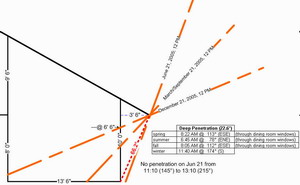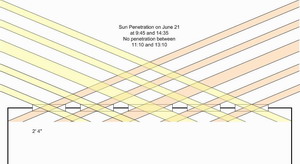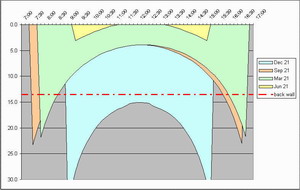Tuesday, May 24, 2005
Embodied Energy
This is really interesting:
One insulating unit (insulation required to provide R-20 for a square foot at normal density) of cellulose has 600 BTU of embodied energy. EPS (expanded polystyrene - CFC-free insulation material used for our walls and probably also the roof) has 18,000 BTUs in the comparable amount of insulation...
http://www.buildinggreen.com/auth/article.cfm?fileName=040101a.xml
Our house's surface area is roughly 3,750 sq.ft. for the walls (R-22 with ICFs) and 2,750 for the roof (R-40 with SIPs). This means our embodied energy, in just the walls and roof is 165.6 Million BTU or 48,535 kWh, i.e., as much electrical energy as we plan to consume in over 26 years. And then there is the cement...and the floor slab with EPS...
But hey - if we burn 2 cords a year, it's only as much as 8 years of using our masonry stove ;-)
(in comparison, if we'd use cellulose in the roof, it's only 1/2 year of electrical energy (instead of 16 years))
Electricity ..... 3,412 Btu/kilowatthour
Natural Gas ..... 1,031 Btu/cubic foot
LPG (Propane) ..... 91,330 Btu/gallon
Wood ..... 20 million Btu/cord
[Thank you for reading my blog. Please share your comments with us - even if you want to say you stopped by and read it. Thanks!]
One insulating unit (insulation required to provide R-20 for a square foot at normal density) of cellulose has 600 BTU of embodied energy. EPS (expanded polystyrene - CFC-free insulation material used for our walls and probably also the roof) has 18,000 BTUs in the comparable amount of insulation...
http://www.buildinggreen.com/auth/article.cfm?fileName=040101a.xml
Our house's surface area is roughly 3,750 sq.ft. for the walls (R-22 with ICFs) and 2,750 for the roof (R-40 with SIPs). This means our embodied energy, in just the walls and roof is 165.6 Million BTU or 48,535 kWh, i.e., as much electrical energy as we plan to consume in over 26 years. And then there is the cement...and the floor slab with EPS...
But hey - if we burn 2 cords a year, it's only as much as 8 years of using our masonry stove ;-)
(in comparison, if we'd use cellulose in the roof, it's only 1/2 year of electrical energy (instead of 16 years))
Electricity ..... 3,412 Btu/kilowatthour
Natural Gas ..... 1,031 Btu/cubic foot
LPG (Propane) ..... 91,330 Btu/gallon
Wood ..... 20 million Btu/cord
[Thank you for reading my blog. Please share your comments with us - even if you want to say you stopped by and read it. Thanks!]
Friday, May 20, 2005
Window, window, in the wall...
...which is the most efficient of them all?
Well, it's time to do some window research again...this time I'll try to take notes so that I don't forget everything again...My first stop for windows research has always been energyefficientwindows.org. Reading through their pages and using their window selector, it seems that we want the following windows:
As I see now, "Insulated Vinyl" has become as energy-efficient as our previously favored Fiberglass. The challenge will be to find a company that makes windows with these characteristics, because it seems that this model windows are just hypothetical windows and don't represent any physically available windows...
[Thank you for reading my blog. Please share your comments with us - even if you just want to say you stopped by and read it. Thanks!]
Well, it's time to do some window research again...this time I'll try to take notes so that I don't forget everything again...My first stop for windows research has always been energyefficientwindows.org. Reading through their pages and using their window selector, it seems that we want the following windows:
- on the south side - window 30:
double-glazed, high-solar-gain, low-e, argon gas, insulated vinyl
(U value of 0.29, SHGC of 0.56 and VT of 0.58). - on the east/west sides - window 33:
triple-glazed, moderate-solar-gain, low-e, argon gas, insulated vinyl
(U value of 0.18, SHGC of 0.40 and VT of 0.50)
As I see now, "Insulated Vinyl" has become as energy-efficient as our previously favored Fiberglass. The challenge will be to find a company that makes windows with these characteristics, because it seems that this model windows are just hypothetical windows and don't represent any physically available windows...
[Thank you for reading my blog. Please share your comments with us - even if you just want to say you stopped by and read it. Thanks!]
Thursday, May 19, 2005
Official Kick-Off
Well, tonight I finally followed through on promises made in the past months...I finalized the plans and the 3D model and sent a note off to Jim from Holabird & Root. We had met with Jim in December 2003 to review our plans (log house with garage in basement back then). And wouldn't you know it? Jim worked with Andy Bunge on two projects last year and this year (Andy's brother's house and the Commonweal Theatre Addition. It's a small world...
So, the countdown can begin...here's what's on my list:
[Thank you for reading my blog. Please share your comments with us - even if you just want to say you stopped by and read it. Thanks!]
So, the countdown can begin...here's what's on my list:
- Get plans reviewed by architect
- Get blue prints
- Secure ICF forms contractor
- “Organize” driveway gravel build-up
- Develop budget with Andy
- Apply for Mortgage
- Contact Masonry Stove builder in Wisconsin
- Create preliminary plumbing plan
- Create preliminary electrical plan
[Thank you for reading my blog. Please share your comments with us - even if you just want to say you stopped by and read it. Thanks!]
Thursday, May 12, 2005
Shading through the south-side overhang
Yesterday when I shared the 3D Model slide show with my colleague Jim, he inquired whether the soffit overhang on the south side will provide enough shading in the summer.
Well it had been about 1.5 years since I last researched "sun altitude" and "sun azimuth". In the meantime the geometry of the roof and south wall had changed quite a bit, so it was time to confirm the sizing of the overhang. I found this site from the U.S. Naval observatory to get sun (or moon) altitude and azimuth tables for a given date at a given location.
 In the picture on the right you can see the different penetration levels at 12 PM noon on June 21, March & September 21 and December 21. As you can see, the overhang completely shades the midday sun in the summer (most left beam) whereas in the winter, even at high noon, the sun will penetrate as far as the back wall of the living room. (Click on the picture to open a full-size version in a separate window.)
In the picture on the right you can see the different penetration levels at 12 PM noon on June 21, March & September 21 and December 21. As you can see, the overhang completely shades the midday sun in the summer (most left beam) whereas in the winter, even at high noon, the sun will penetrate as far as the back wall of the living room. (Click on the picture to open a full-size version in a separate window.) since the sun is pretty much still in the ESE (112.5°) or WSW (202.5°). The suprising thing for me was that the overhang pretty much prevents even that early sun to penetrate the room - the deepest penetration is about 3 feet (at an azimuth of 109° with an even lower percentage of what makes it in). and the penetration rapidly declines to zero by around 11:10 AM and does not penetrate at all until 13:10.
since the sun is pretty much still in the ESE (112.5°) or WSW (202.5°). The suprising thing for me was that the overhang pretty much prevents even that early sun to penetrate the room - the deepest penetration is about 3 feet (at an azimuth of 109° with an even lower percentage of what makes it in). and the penetration rapidly declines to zero by around 11:10 AM and does not penetrate at all until 13:10.As some of you might recall, on the east side of the dining room, we do have the same large windows as on the south side, but with no overhang (at least only in the gables), so the sun will penetrate the living room from that side for the most part of the morning. This is actually by design, because in the spring time, it tends to stay pretty cold (yesterday the high temperature was 42°F), especially in March or April. At our place the sun rises pretty much in the east, but due to some trees we probably won't see much of it until it is about 10° high, at around 7 AM at 10° south of east. For the summer, when the sun reaches 10° altitude at 5:40 AM in the ENE (67.5°) we definitely will have to employ shades on these windows. Fortunately, and also by design, this is not so much of a problem on the west side, where the windows are much smaller, due to the sitting area. But shades would probably also help here as well.
 The last simulation I ran with the data is to plot the penetration depth for each of the four dates. The graph on the right shows the penetration level at the various times of the day for the four dates during the year. The nice thing that you can see is that the penetration during the winter time can reach the backwall unhinderedly when the sun's azimuth is between ESE and WSW.
The last simulation I ran with the data is to plot the penetration depth for each of the four dates. The graph on the right shows the penetration level at the various times of the day for the four dates during the year. The nice thing that you can see is that the penetration during the winter time can reach the backwall unhinderedly when the sun's azimuth is between ESE and WSW.In summary, the theory looks good for the sizing of our overhang on the south side. The 80" (6' 8" or 203 cm) windows now allow unhindered penetration into the room during the winter months which should help with the heating on sunny days. The 475 sq. ft., four inch thick cement slab definitely will have enough capacity to store any heat coming through the windows, and with 168 sq. ft. of window space for 1,500 sq. ft. of main and 2nd floor living space (i.e., 11%), we might be a little bit over the recommended percentage for south-facing glazing, but we'd rather shade windows in the summer time then having to freeze. And our large thermal mass (including the masonry stove) should help mitigate overheating. We can also always open the door to the basement - to add another 1,100 sq.ft. of living space...(or the garage to add 485 sq. ft.).
Update on Project Licht 'n Stein
Well, it has been almost 15 months since the last blog entry.
But finally, there's a little bit more life in our project -- last weekend during the Kid's Philosophy slam in Lanesboro I had a chance to chat with our General Contractor and it seems that since he is still very interested in shepherding our project.
So hopefully, given the already advanced year, we might get at least an enclosed structure (i.e., concrete walls, windows, & roof) and masonry stove done before winter, which would make us self-sufficient (i.e., heating, water & electricity) to finish the interior during the winter...
The next steps for me are:
What's New
Slide Show of the 3D model (and floor plans)
Updated (but not completed) description of components
especially: shelter & water
But finally, there's a little bit more life in our project -- last weekend during the Kid's Philosophy slam in Lanesboro I had a chance to chat with our General Contractor and it seems that since he is still very interested in shepherding our project.
So hopefully, given the already advanced year, we might get at least an enclosed structure (i.e., concrete walls, windows, & roof) and masonry stove done before winter, which would make us self-sufficient (i.e., heating, water & electricity) to finish the interior during the winter...
The next steps for me are:
- share the revised floor plans & 3D Model (see link below) with the architect and get some load calculations done and probably some blueprints drafted
- get estimates for some driveway buildup
- contact concrete contractors (such as Wellik out of Stewartville) to check their availability.
What's New
Slide Show of the 3D model (and floor plans)
Updated (but not completed) description of components
especially: shelter & water